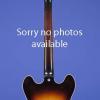Guild's First Solid Body -- A Curious Lopsided "Gumby"-Shaped Off-Set Double-Cutaway Guitar
This curious lopsided "Gumby"-shaped off-set double-cutaway guitar weighs 8.20 lbs. and has a nice, fat nut width of over 1 11/16 inches and a scale length of 24 3/4 inches. Solid mahogany body with a metal "kickstand" built into the back of the body, mahogany neck, and bound rosewood fretboard with 22 frets and pearloid block position markers. Asymmetrical headstock with inlaid pearl peaked "Guild" logo and pearloid "Bird" inlay. "Thunderbird" on metal truss-rod cover. Individual open-back Grover StaTite tuners with cloverleaf-shaped metal buttons. Serial number ("40388") stamped into the back of the headstock. Two first-style Guild small humbucker pickups ("Anti-Hum Pickups") with outputs of 8.24k and 6.40k. Four-layer (black/white/black/white) plastic pickguard. Four controls (master volume and tone controls plus volume and tone controls for the neck pickup), three on/off slider switches (two black pickup selectors and a white phase switch) on an oblong metal plate on the upper treble bout, one on/off slider switch (for the panel of three switches) on a small diagonal metal plate beside the bridge pickup, and jack socket, all on pickguard. Black plastic knobs with white markings, the volume and tone controls for the neck pickup with G-logo on silver disc. Hagström-made AdjustoMatic bridge and vibrato tailpiece. Two of the pots are dated "137 65 03" and the other two are dated "137 63 38." This guitar is in near mint (9.25) condition, with very slight belt buckle wear on the back of the guitar, a few tiny marks on the back, some natural playing wear on the edge of the neck (especially on the treble side between the third and seventh fret), a few small marks on the edge of the guitar, and a couple of marks on the top on the bass horn of the guitar. Housed in the original Guild black sparkle hardshell case with black imitation crocodile ends and with red plush lining and original shaped red plush pads (9.00).
"In 1963 Guild began making solidbody electrics, producing many excellent instruments -- even some classics -- yet never really finding success. Guild's first solidbody was one of the most unusual American guitars of the 1960s, the lumpy "Gumby"-shaped S-200 Thunderbird, available from 1963-68. Not only was the shape unusual, but the guitar featured a very early example of phase-switching (for a different pickup sound) and more importantly was one of only two guitars ever to incorporate a metal stand built into the back. Despite these oddities, the Thunderbird had enough appeal to win over an eclectic bunch of players, including Muddy Waters, Zal Yanofsky, Jorma Kaukonen and Banana. The Thunderbird was joined by two other similarly shaped solids, the plainer S-100 Polara (also with built-in stand) and the single-pickup S-50 Jet Star, both gone by the late 1960s. The S-200 and S-100 featured Swedish Hagstrom vibratos" (Tony Bacon, Electric Guitars: The Illustrated Encyclopedia, p. 182).
"This is the mighty Guild Thunderbird S-200. Available in either sunburst or cherry finishes, this is a striking guitar as are its less expensive cousins the S-100 (Polara) and the S-50 (Jet Star). These are the first Guild solid bodies and the T-bird ruled the roost. With its asymmetrical body and headstock, and its bold Bird inlay, the Thunderbird was Guild's declaration that the company wanted to be a player in the solid-body market, and would not merely copy the signature guitars of Gibson and Fender. The Thunderbird, introduced in 1963, sported more than just a nifty design. Its most unusual feature was its built-in stand which is also found on the S-100. This fold out unit proved to be a boon for both gigging musicians and for luthiers. While this baby looks cool as all get out, it does lack something in the stability department. One can almost hear the cries of 'timber' that punctuated band breaks. Mark Dronge, son of Guild's founder and sales exec with the company in the 1960's, was responsible for the basic design of the Thunderbird, but not, he exclaims, for the built in stand. He left town in the middle of the design process for a two week sales trip. Upon his return, he found that his father and Guild's sales director had bedecked the Thunderbird with its gumby headstock, derived from Merle Travis model Guild, and the aforementioned 'crash-o-matic' stand. But most important for tone are the three switches up there on the treble side of the upper bout. These, combined with the single slider switch just south of the bridge pickup and the normal tone and volume controls, give the player a wide variety of sonic options. The single slider switch is an on/off for the panel of three. When these are on, they act as pickup selectors and a phase switch. The guitar was normally equipped with two Guild humbuckers, but some were made with single coil pickups. The most notable of these latter instruments is the one pictured with Muddy Waters. These are really nice instruments that beg to be played in any number of styles. They have been praised for their tone in all sorts of music from rock to slide blues" (from Jay Pilzer and Alan McDonald, "Forgotten Guilds VII," at http://www.guildguy.com/fgp7.html).
Translate:

